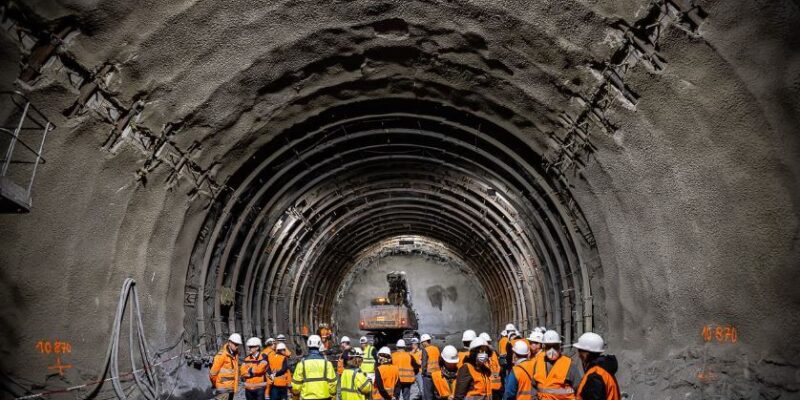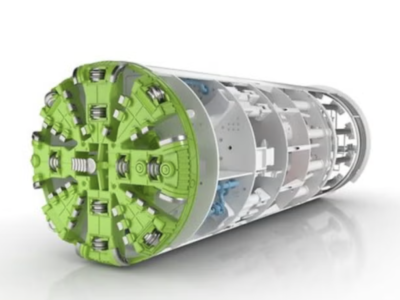
In order to excavating the next 9 km beneath Mont Cenis, the companies cooperate with the public promoter and witnessed the trials of the intended machine.
Considering that the excavation process of the two 57.5 km-long tubes of the Mont Cenis base tunnel, which is the main work of the new Lyon-Turin freight and passenger railway line, is due to be completed by the first of the forthcoming seven TBMs, on 7 July 2023 this machine has been unveiled at the Herrenknecht factory in Germany.
The French-Italian group of companies denominated CO 6-7, consisting of VINCI Construction Grands Projets (contractor), Webuild, Dodin Campenon Bernard and Campenon Bernard Centre Est, recived the intended TBM with 180-metre length and 10.4-metre diameter.
Locating between Saint-Martin-la-Porte and La Praz, 9 km of the northern tube of the base tunnel is going to be completed by this TBM, whereas running parallel with the part completed in 2019 by the Federica TBM. Additionally, the responsibility of boring the tunnels in the section between La Praz and Modane for the same 6-7 construction site, is up to two more TBMs that are being built.
Also present at the delivery ceremony were the top management of TELT, the binational public promoter in charge of carrying out the work, the managers of the SETEC/Systra/Italferr and PINI group construction management team, as well as representatives of DG Move – the European Commission responsible for mobility and transport policies – and CINEA – the European Climate, Infrastructure and Environment Executive Agency, which is coordinating the European Commission’s programs for decarburization and sustainable growth. The delivery of the TBM is one of the landmarks of the financing agreements between France, Italy, and the European Union.
According to Gilles Dumoulin, Project Director: “The delivery of the first TBM to operational construction sites 6 and 7 in just 10 months demonstrates the incredible passion and motivation of our team, our construction management and Herrenknecht to achieve great things on time and safely. We are looking forward to a great adventure.”
The TBM
Being designed, manufactured, and assembled in 10 months at Herrenknecht’s plant in Schwanau, Baden-Württemberg, the construction of this TBM involved numerous European companies, including a dozen in Italy and France.
The numbers involved for this underground giant are impressive: 8,100 kilowatts of power, 2,300 tons in weight and a head with 61 rotating cutters – the teeth that crush the rock and allow the machine to advance into the mountain. In addition, immediately after the head has moved forward, the cutter covers the living rock of the tunnel with a succession of rings: 8 segments of tunnel lining in reinforced concrete that assure maximum stability of the tunnel through which trains will travel between France and Italy. The TBM consists of a real travelling factory that includes 10 trailers that also transport the extracted rock to the surface on a conveyor belt.
The plan for future months is disassembling and transporting this TBM with 130 special convoys from the Herrenknecht factory to the Saint-Martin-la-Porte platform, where it is slated to be reassembled in the heart of the mountain, and then commence its excavation towards Italy.
Status of Work in progress
Including ten operational underground and above ground construction sites on both sides of the Alps, the construction process of the international section of the Lyon-Turin line from Saint-Jean-de-Maurienne in France to Susa in Italy, is undergoing. While digging of four access adits has been completed, over than 20% of the 162 km of tunnels planned for the project have been excavated to date, and with the sites at full capacity, with 4,000 people at work and 15 active excavation fronts, 7 TBMs will advance simultaneously to complete the two tunnel tubes.
As the central link in the Mediterranean Corridor, the Mont Cenis base tunnel constitutes one of the 9 axes of the TEN-T railway network under construction throughout Europe. Allowing trains to bypass the Alps at the level of the plain, making transport more energy-efficient and economical for both freight and passengers, as well as becoming the most sustainable alternative to trucks and aeroplanes, are the advantages of this new tunnel.
For further information please visit here.
















